Application of Machine Learning in the Identification and Prediction of Maritime Accident Factors
Abstract
:1. Introduction
2. Materials and Methods
2.1. Database and Codification
2.2. ANOVA
2.3. Clustering
2.4. Neural Networks
3. Results and Discussion
3.1. Database
3.2. Identification of Principal Variables
3.2.1. ANOVA Analysis
3.2.2. Random Forest Variables
3.3. Clustering
3.3.1. Clusters 1 and 2
3.3.2. Clusters 6 to 8
3.4. Neural Networks
4. Conclusions
- The main variable related to maritime accidents in the SAR region is the enforcement of the minimum crew members and, at a lower level, the ship dimensions, which, indirectly, are associated with the ship type.
- The results are centred in the SAR region, and this original methodology must be tested in another region where weather conditions and new variables like crew members’ experience can affect the selection of the more relevant variables.
- Three main clusters can be observed in Figure 6, Figure 7, Figure 8 and Figure 9 based on their three main colours (cluster 1 (in white), cluster 2 (light green) and cluster 3 (dark green), which are associated with the meeting of the minimum crew member requirement and that are differentiated by the year of construction of the ship. At the same time, based on the 3D model, it can be concluded that a more adequate definition of the minimum number of crew members may help to decrease the number of accidents.
- It is possible to obtain a mathematical model based on feedforward neural networks that let us predict the expected type of accident at any moment based on the year of construction, wind force, nighttime, length, beam and minimum crew with a determination factor over 67%, and new variables associated with the human factor could increase this result in future works.
- An electronic control system based on this model can be of interest to predict and prevent future maritime accidents in this region.
Author Contributions
Funding
Institutional Review Board Statement
Informed Consent Statement
Data Availability Statement
Conflicts of Interest
Appendix A
| Code | Ship Type |
|---|---|
| 1 | Extraction Platforms and Auxiliary Supply vessels |
| 2 | Passenger and/or cargo vessels |
| 3 | Fishing vessels |
| 4 | Fishing and Aquaculture Auxiliary Boats |
| 5 | Tugboats and auxiliary boats of the Port Service |
| 6 | Commercial Yachts |
| 7 | Recreational Boats |
| 8 | Vessels of Public Organizations (National or Autonomous Communities) |
| 9 | Provisional List of Vessels under Construction |
| Code | Type of Accident |
|---|---|
| 1 | Contact |
| 2 | Flooding |
| 3 | Grounding |
| 4 | Collision |
| 5 | Fire |
| 6 | Capsizing |
| 7 | List |
| 8 | Stranded |
| 9 | Loss of Stability |
| 10 | Operational Accident |
| Code | Denomination | |
|---|---|---|
| One ship involved | Two ships involved | |
| 1 | Meets | - |
| 2 | Do not meet | - |
| 3 | - | One does not meet |
| 4 | - | Two do not meet |
| 5 | - | Two meet |
| Code | Visibility Level |
|---|---|
| 1 | Very Bad (less than 1000 m) |
| 2 | Bad (between 1000 m and 2 nautical miles) |
| 3 | Moderate (between 2 nautical miles and 5 nautical miles) |
| 4 | Good (more than 5 nautical miles) |
| Code | Period of Time |
|---|---|
| 1 | Day |
| 2 | Night |
| Code | Human Factor Conditions |
|---|---|
| 1 | Human factor influences the accident |
| 2 | Human factor does not influence the accident |
| 3 | Doubtful |
| Wind Force (Code) | Denomination | Velocity | |
|---|---|---|---|
| (km/h) | Knots | ||
| 0 | Calm | 0–2 | Till 1 |
| 1 | Light air | 2–6 | 1–3 |
| 2 | Light breeze | 7–11 | 4–6 |
| 3 | Gentle breeze | 12–19 | 7–10 |
| 4 | Moderate breeze | 20–29 | 11–16 |
| 5 | Fresh breeze | 30–39 | 17–21 |
| 6 | Strong breeze | 40–50 | 22–27 |
| 7 | High wind | 51–61 | 28–33 |
| 8 | Gale | 62–74 | 24–40 |
| 9 | Strong gale | 75–87 | 41–47 |
| 10 | Storm | 88–101 | 48–55 |
| 11 | Violent storm | 102–107 | 56–63 |
| 12 | Hurricane force | >118 | >64 |
| Sea Conditions (Code) | Douglas Scale | Wave Height | Beaufort Scale | |
|---|---|---|---|---|
| (m) | (ft) | |||
| 0 | Calm (Glassy) | No wave | 0 | |
| 1 | Calm (rippled) | 0–0.10 | 0.00–0.33 | 1–2 |
| 2 | Smooth | 0.10–0.50 | 0.33–1.64 | 3 |
| 3 | Slight | 0.50–1.25 | 1.6–4.1 | 4 |
| 4 | Moderate | 1.25–2.50 | 4.1–8.2 | 5 |
| 5 | Rough | 2.50–4.00 | 8.2–13.1 | 6 |
| 6 | Very rough | 4.00–6.00 | 13.1–19.7 | 7 |
| 7 | High | 6.00–9.00 | 19.7–29.5 | 8–9 |
| 8 | Very high | 9.00–14.00 | 29.5–45.9 | 10–11 |
| 9 | Phenomenal | 14.00+ | 45.9+ | 12 |
| Ship Type | Accident | Year | Wind Direction | Wind Force | Sea | Visibility | Day/ Night | Length | Beam | Gt. M | Crew | Minimum Crew | Human Factor Influence |
|---|---|---|---|---|---|---|---|---|---|---|---|---|---|
| 3 | 6 | 1985 | 203 | 4 | 3 | 3 | 1 | 5 | 2 | 1 | 2 | 1 | 1 |
| 3 | 8 | 1967 | 338 | 3 | 2 | 3 | 1 | 5 | 2 | 1 | 1 | 1 | 0 |
| 3 | 6 | 1991 | 338 | 5 | 2 | 2 | 1 | 5 | 2 | 1 | 2 | 1 | 1 |
| 3 | 4 | 1994 | 180 | 3 | 2 | 4 | 2 | 5 | 2 | 1 | 1 | 2 | 0 |
References
- Awal, Z.I.; Kazuhiko, H. A Study on Accident Theories and Application to Maritime Accidents. Procedia Eng. 2017, 194, 298–306. [Google Scholar] [CrossRef]
- Allianz. Safety and Shipping 1912–2012 from Titanic to Costa Concordia. 2012. Available online: https://www.allianz.com/content/dam/onemarketing/azcom/Allianz_com/migration/media/press/document/other/agcs_safety_shipping_1912-2012.pdf (accessed on 2 August 2024).
- Dominguez-Pery, C.; Vuddaraju, L.N.R.; Corbett-Etchevers, I.; Tassabehji, R. Reducing maritime accidents in ships by tackling human error: A bibliometric review and research agenda. J. Ship. Trade 2021, 6, 20. [Google Scholar] [CrossRef]
- AISM—IALA. IALA Recommendation O-134. On the IALA Risk Management Tool for Ports and Restricted Waterways, 2nd ed.; AISM—IALA: Saint Germain in Laye, France, 2009; Available online: https://www.iala-aism.org/content/uploads/2016/07/o_134_ed2_iala_risk_management_tool_for_ports_and_restricted_waterways_may2009.pdf (accessed on 14 September 2020).
- Friis-Hansen, P. IWRAP MKII Working Document: Basic Modelling Principles for Prediction of Collision and Grounding Frequencies. Technical University of Denmark. 2008. Available online: https://www.iala-aism.org/wiki/iwrap/images/2/2b/IWRAP_Theory.pdf (accessed on 20 July 2024).
- Fujii, Y.; Yamanouchi, H.; Mizuki, N. Some Factors Affecting the Frequency of Accidents in Marine Traffic. II: The probability of Stranding, III: The Effect of Darkness on the Probability of Stranding. J. Navig. 1974, 27, 235–252. [Google Scholar] [CrossRef]
- Hanzu-Pazara, R.; Barsan, E.; Arsenie, P.; Chiotoriou, L.; Raicu, G. Reducing of maritime accidents caused by human factors using simulators in training process. J. Marit. Res. 2008, 5, 3–18. Available online: https://www.jmr.unican.es/index.php/jmr/article/view/32/30 (accessed on 14 August 2024).
- Youn, I.-H.; Park, D.-J.; Yim, J.-B. Analysis of lookout activity in a simulated environment to investigate maritime accidents caused by human error. Appl. Sci. 2019, 9, 4. [Google Scholar] [CrossRef]
- Galierikova, A. The human factor and maritime safety. In Proceedings of the 13th International Scientific Conference on Sustainable, Modern and Safe Transport, Novy Smokovec, Slovak Republic, 29–31 May 2019. [Google Scholar] [CrossRef]
- Rafiqul Islam, M.; Ibn Awal, Z.; Maimum, A. Development of a mathematical model for analysis on ship collision dynamics. In Proceedings of the International Conference on Mechanical Engineering, Dhaka, Bangladesh, 29–31 September 2007; Volume 3, pp. 819–834, ICME07-AM-47. Available online: https://zobair.buet.ac.bd/Publications/2008%20-%20Islam%20et%20al.pdf (accessed on 14 August 2024).
- Vinagre-Ríos, J.; Pérez-Canosa, J.M.; Iglesias-Baniela, S. The effect of circadian rhythms on shipping accidents. J. Navig. 2021, 74, 1189–1199. [Google Scholar] [CrossRef]
- Liu, C.P.; Ching-Wu, C.; Gin-Shuh, L.; Su, Y. Establishing marine accident classification: A case study in Taiwan. J. East Asia Soc. Transp. Stud. 2005, 6, 952–967. [Google Scholar] [CrossRef]
- Ulusçu, O.S.; Özbaç, B.; Altiok, T.; Or, I. Risk analysis of the vessel traffic in the Strait of Istanbul. Risk Anal. 2009, 29, 1454–1472. [Google Scholar] [CrossRef] [PubMed]
- Håvold, J.I. Safety culture aboard fishing vessels. Saf. Sci. 2010, 48, 1054–1061. [Google Scholar] [CrossRef]
- Alvite-Castro, J.; Orosa, J.A.; Vergara, D.; Costa, A.M.; Bouzón, R. A new design criterion to improve the intact stability of Galician small fishing vessels. J. Mar. Sci. Eng. 2020, 8, 499. [Google Scholar] [CrossRef]
- Ozguc, O. Structural damage of ship-FPSO collisions. J. Mar. Eng. Technol. 2019, 18, 1–35. [Google Scholar] [CrossRef]
- Wang, J.; Pillay, A.; Kwon, Y.; Wall, A.; Loughran, C. An analysis of fishing vessel accidents. Accid. Anal. Prev. 2005, 37, 1019–1024. [Google Scholar] [CrossRef] [PubMed]
- Laursen, L.H.; Hansen, H.L.; Jensen, O.C. Fatal occupational accidents in Danish fishing vessels 1989–2005. Int. J. Inj. Control Saf. Promot. 2008, 15, 109–117. [Google Scholar] [CrossRef] [PubMed]
- Spanish Commission for Investigation of Maritime Accidents and Incidents, CIAIM. Available online: https://www.transportes.gob.es/organos-colegiados/ciaim (accessed on 20 July 2024).
- Hasanspahic, N.; Vujicic, S.; Francic, V.; Campara, L. The Role of the Human Factor in Marine Accidents. J. Mar. Sci. Eng. 2021, 9, 261. [Google Scholar] [CrossRef]
- Wróbel, K. Searching for the origins of the myth. 80% human error impact on maritime safety. Reliab. Eng. Syst. Saf. 2016, 216, 107942. [Google Scholar] [CrossRef]
- Salvamento Maritimo Español. Available online: http://www.salvamentomaritimo.es (accessed on 20 July 2024).
- Zhang, X.; Mahadevan, S. Bayesian network modelling of accident investigation reports for aviation safety assessment. Reliab. Eng. Syst. Saf. 2021, 209, 107371. [Google Scholar] [CrossRef]
- Leo Breiman, L.; Adele Cutler, A. Classification and Regression Based on a Forest of Trees Using Random Inputs. (2015-10-07 08:38:34). Available online: https://www.stat.berkeley.edu/~breiman/RandomForests/ (accessed on 20 July 2024).
- Maceiras, C.; Pérez-Canosa, J.M.; Vergara, D.; Orosa, J.A. A Detailed Identification of Classificatory Variables in Ship Accidents: A Spanish Case Study. J. Mar. Sci. Eng. 2021, 9, 192. [Google Scholar] [CrossRef]
- Mohamed Nafuri, A.F.; Sani, N.S.; Zainudin, N.F.A.; Rahman, A.H.A.; Aliff, M. Clustering Analysis for Classifying Student Academic Performance in Higher Education. Appl. Sci. 2022, 12, 9467. [Google Scholar] [CrossRef]
- Udpa, S.S.; Udpa, L. NDT Techniques: Signal and Image Processing. In Encyclopedia of Materials: Science and Technology, 2nd ed.; Elsevier: Amsterdam, The Netherlands, 2001; pp. 6033–6035. [Google Scholar] [CrossRef]


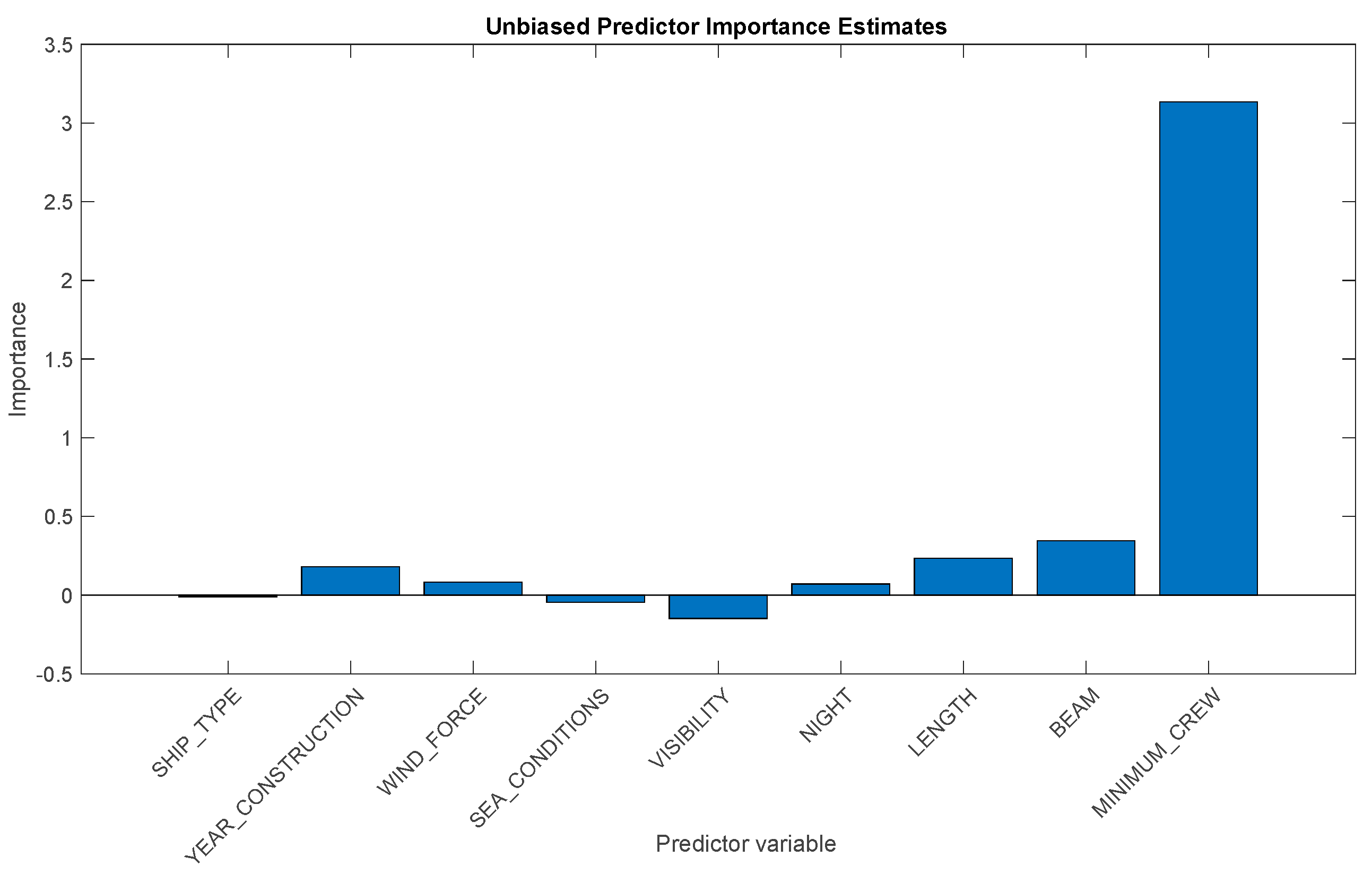
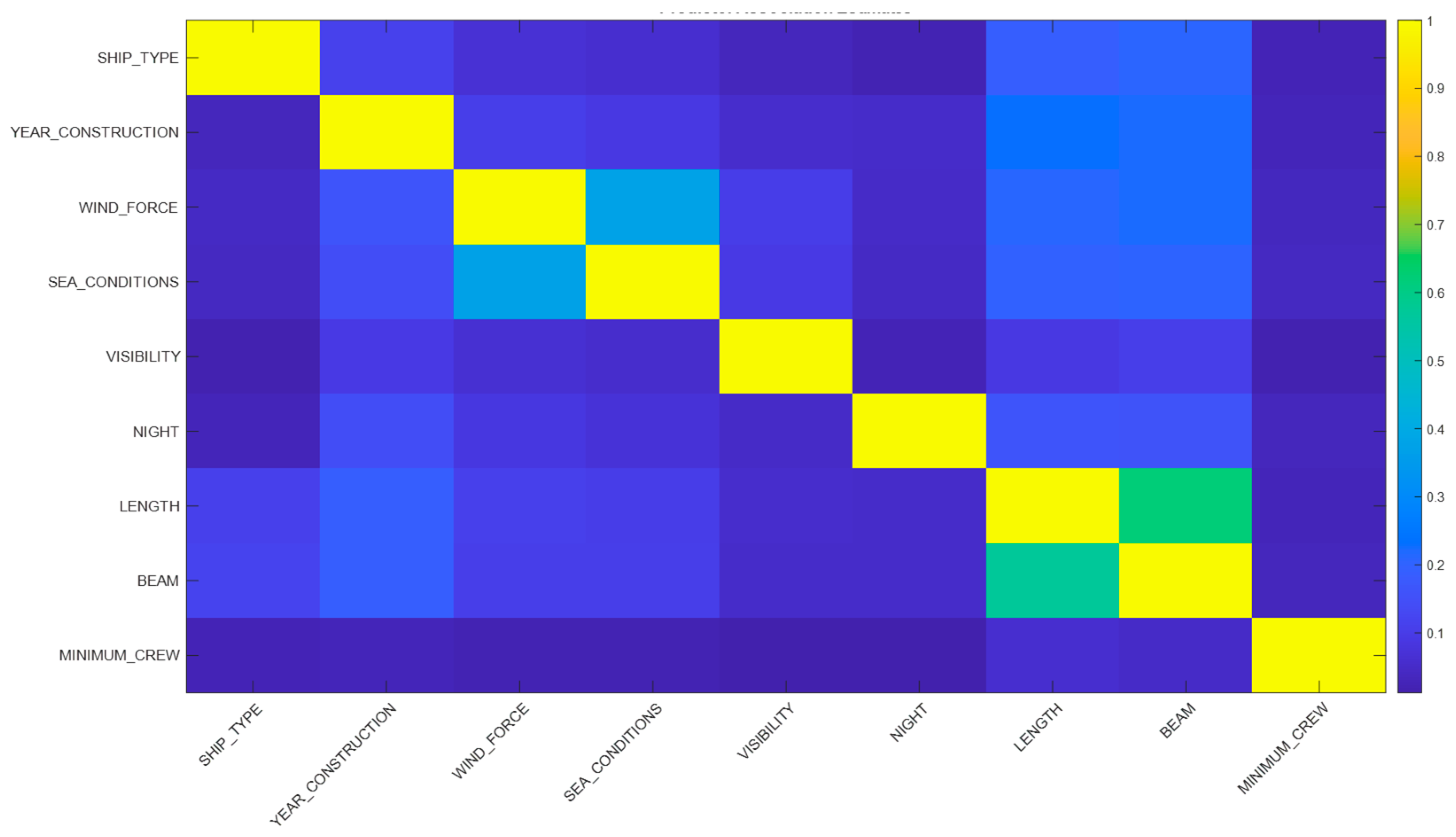
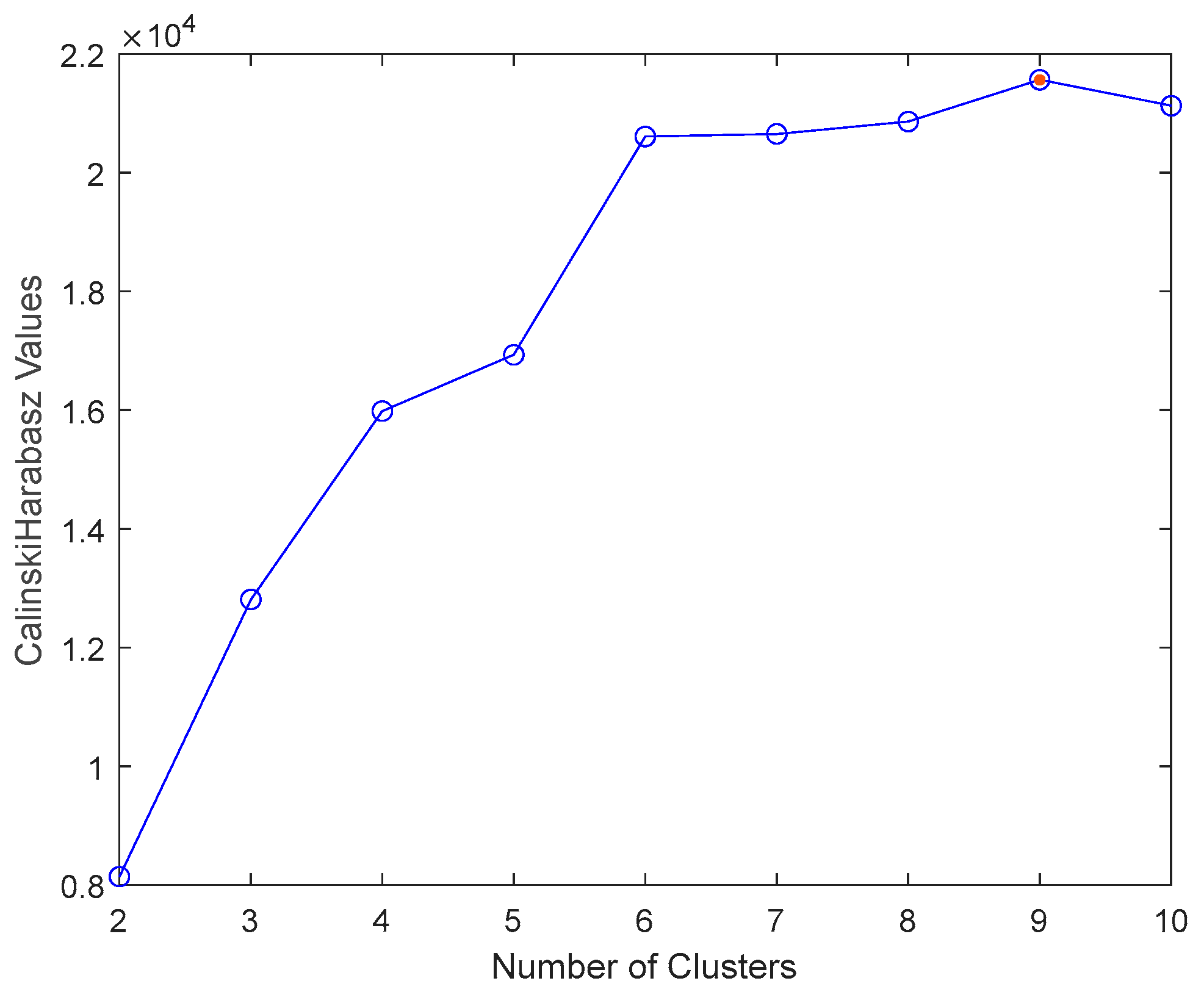
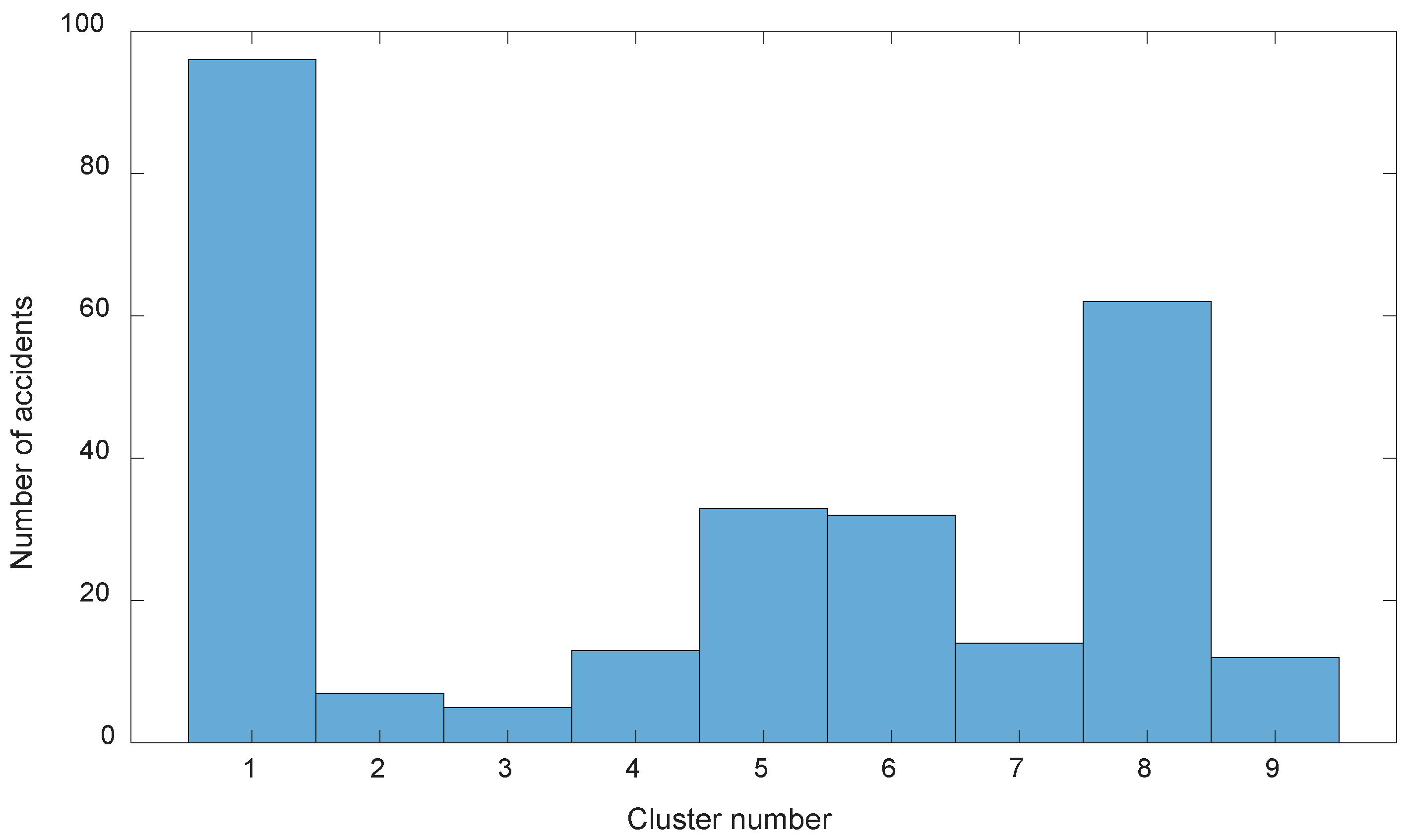
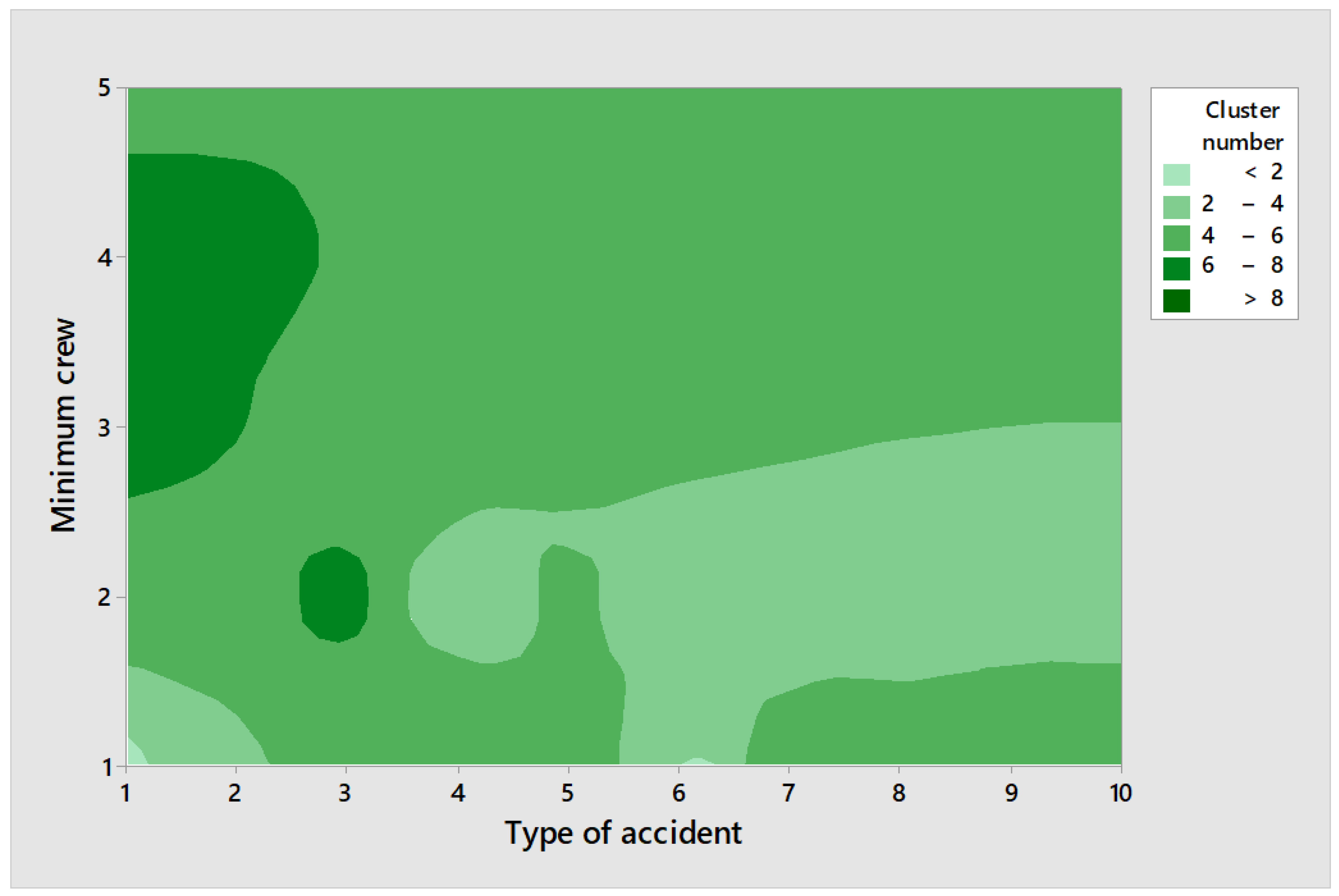
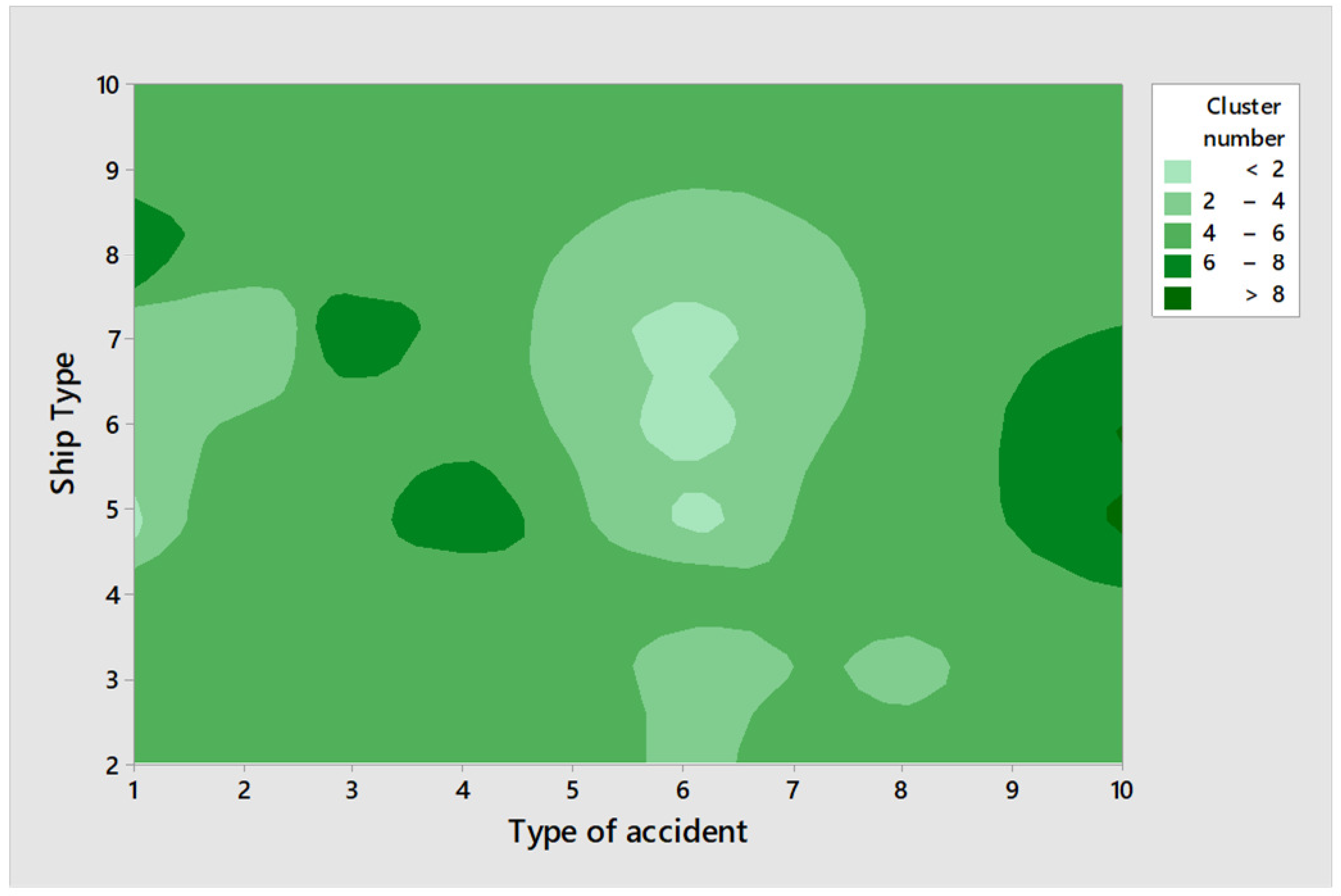
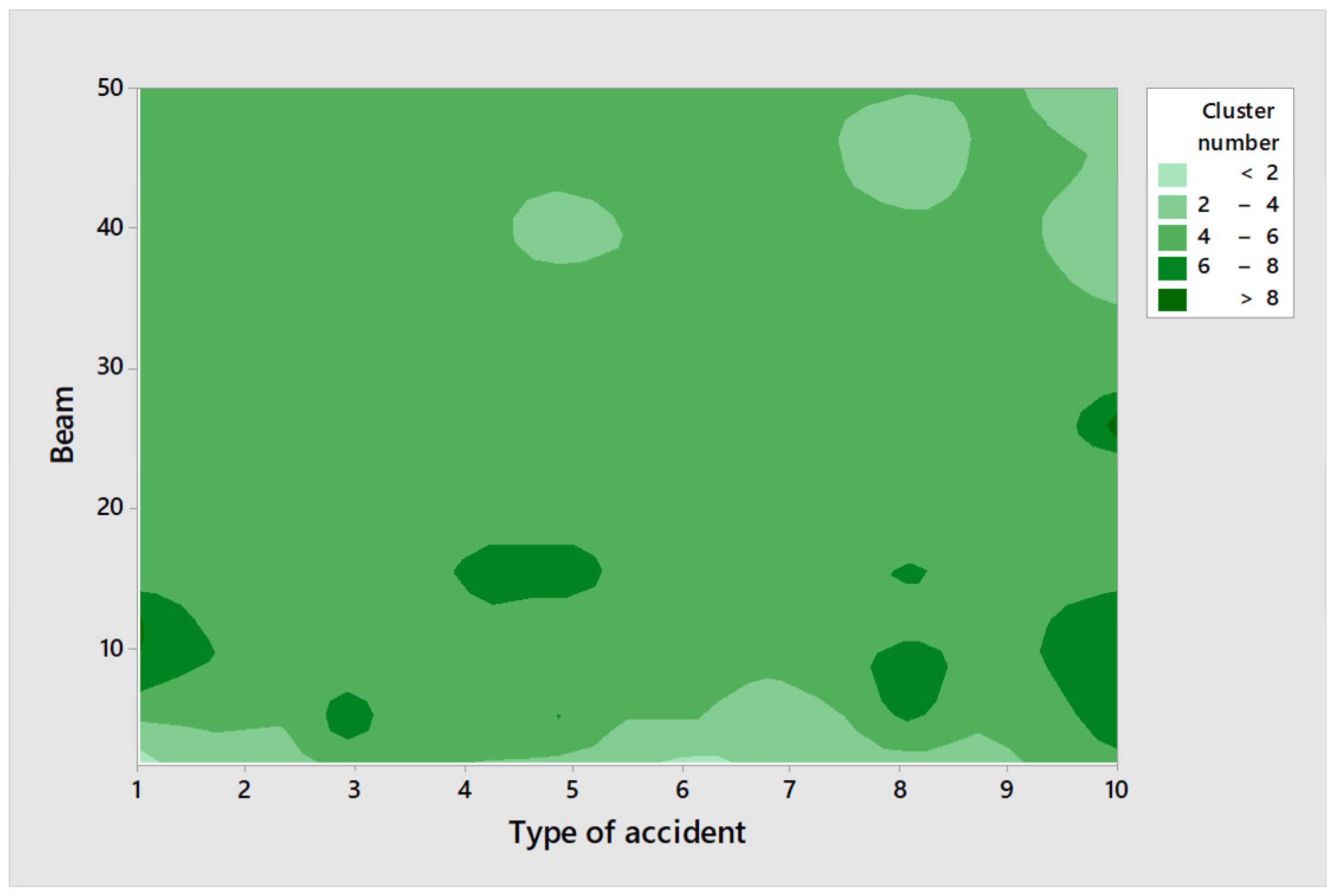

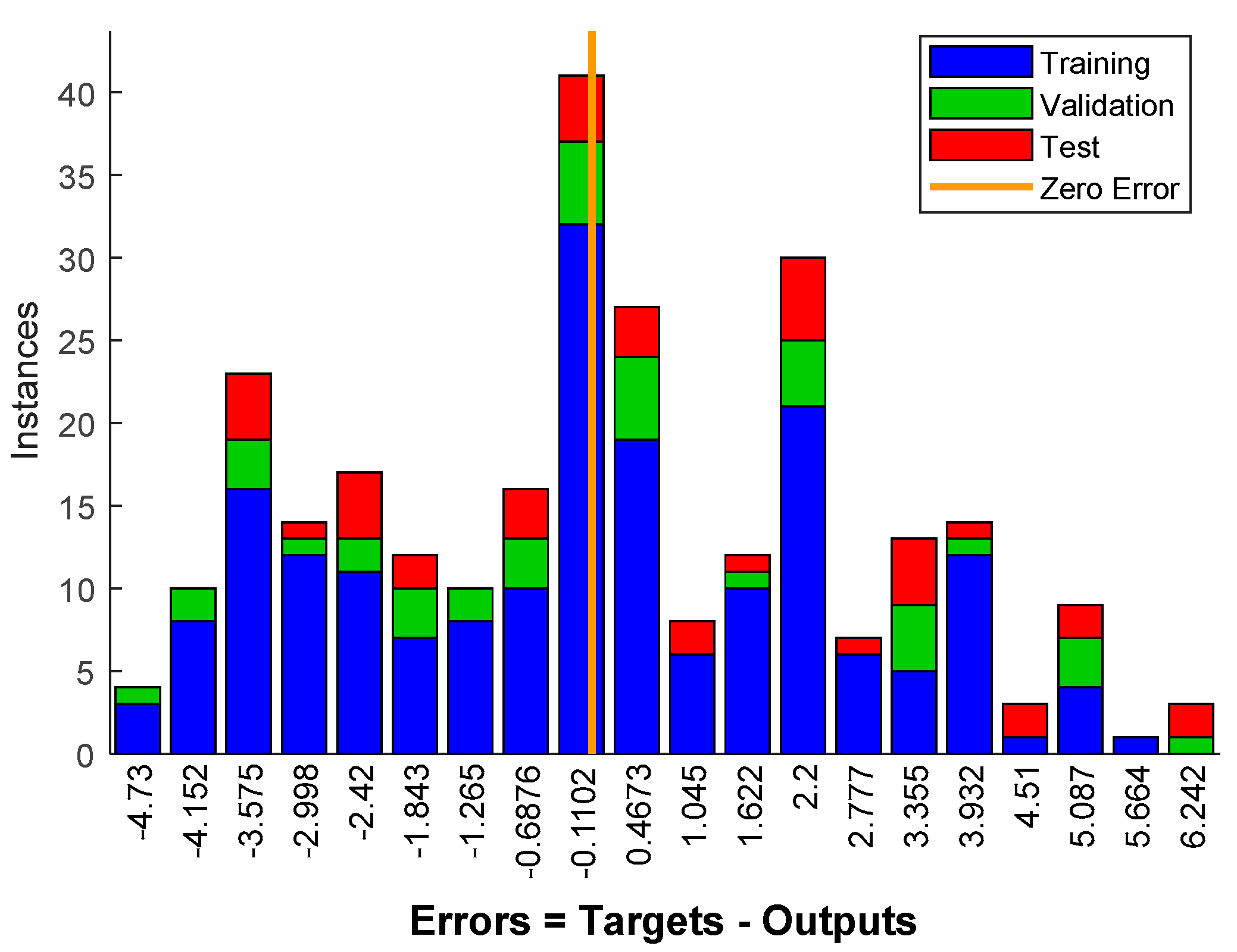
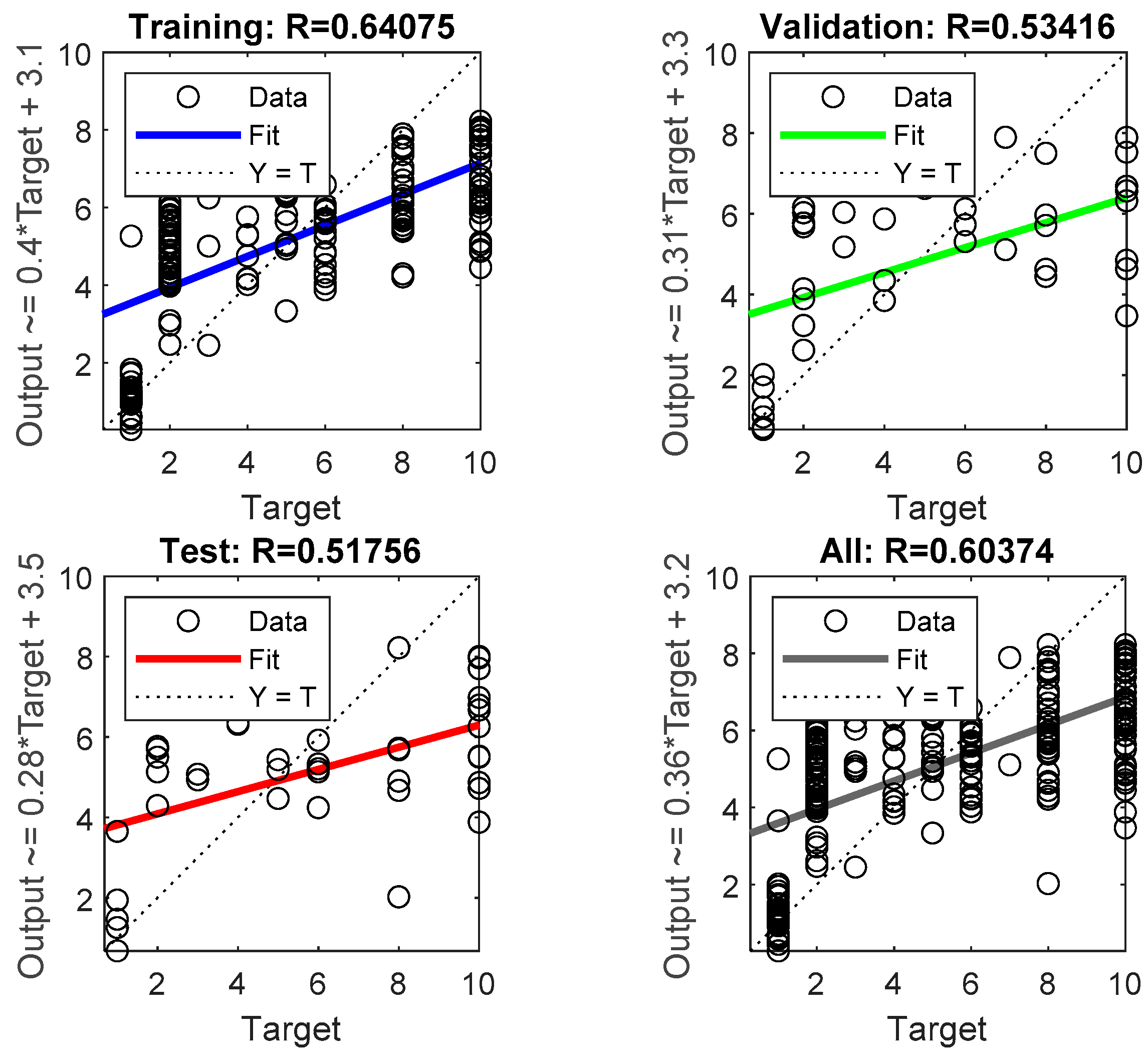
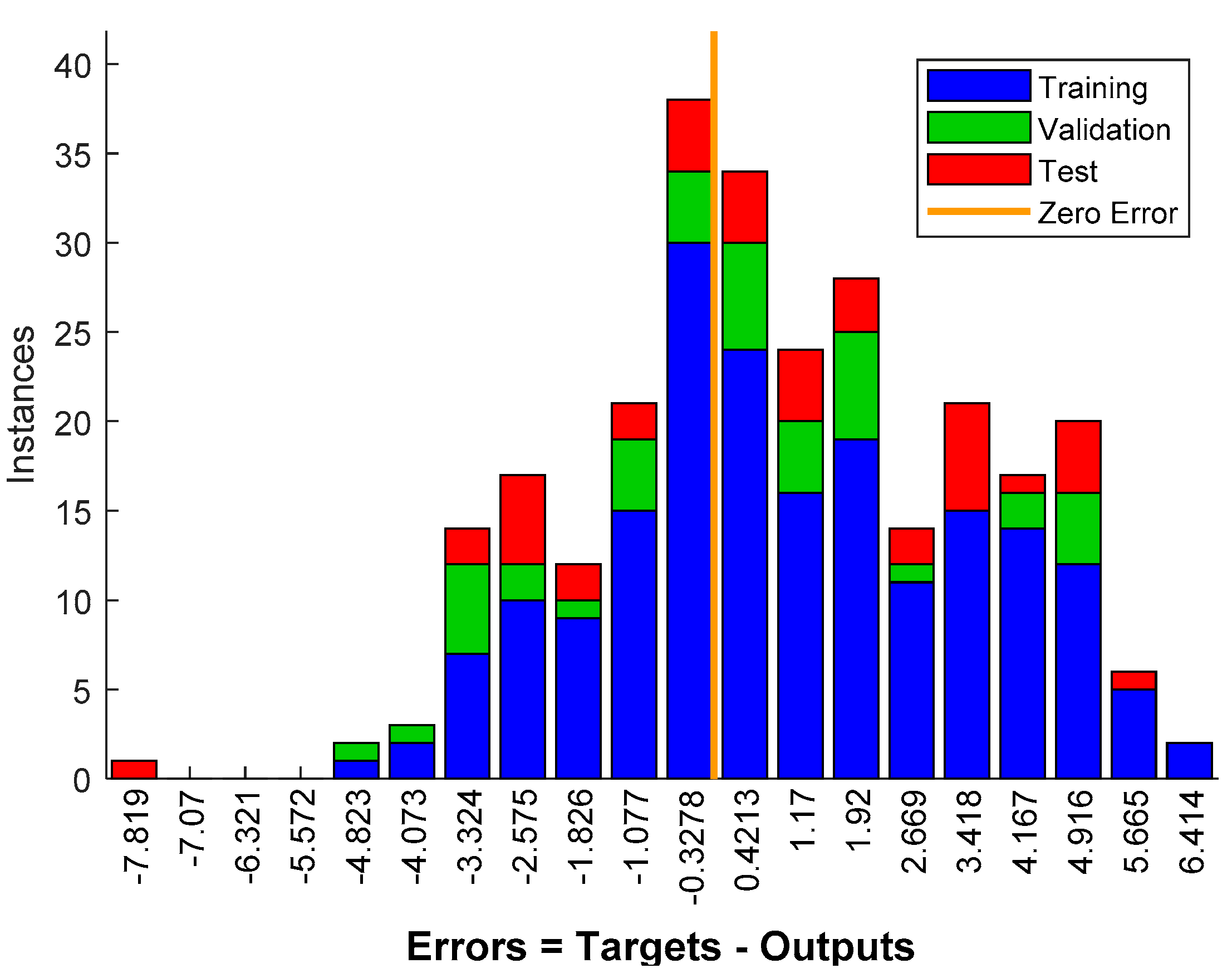
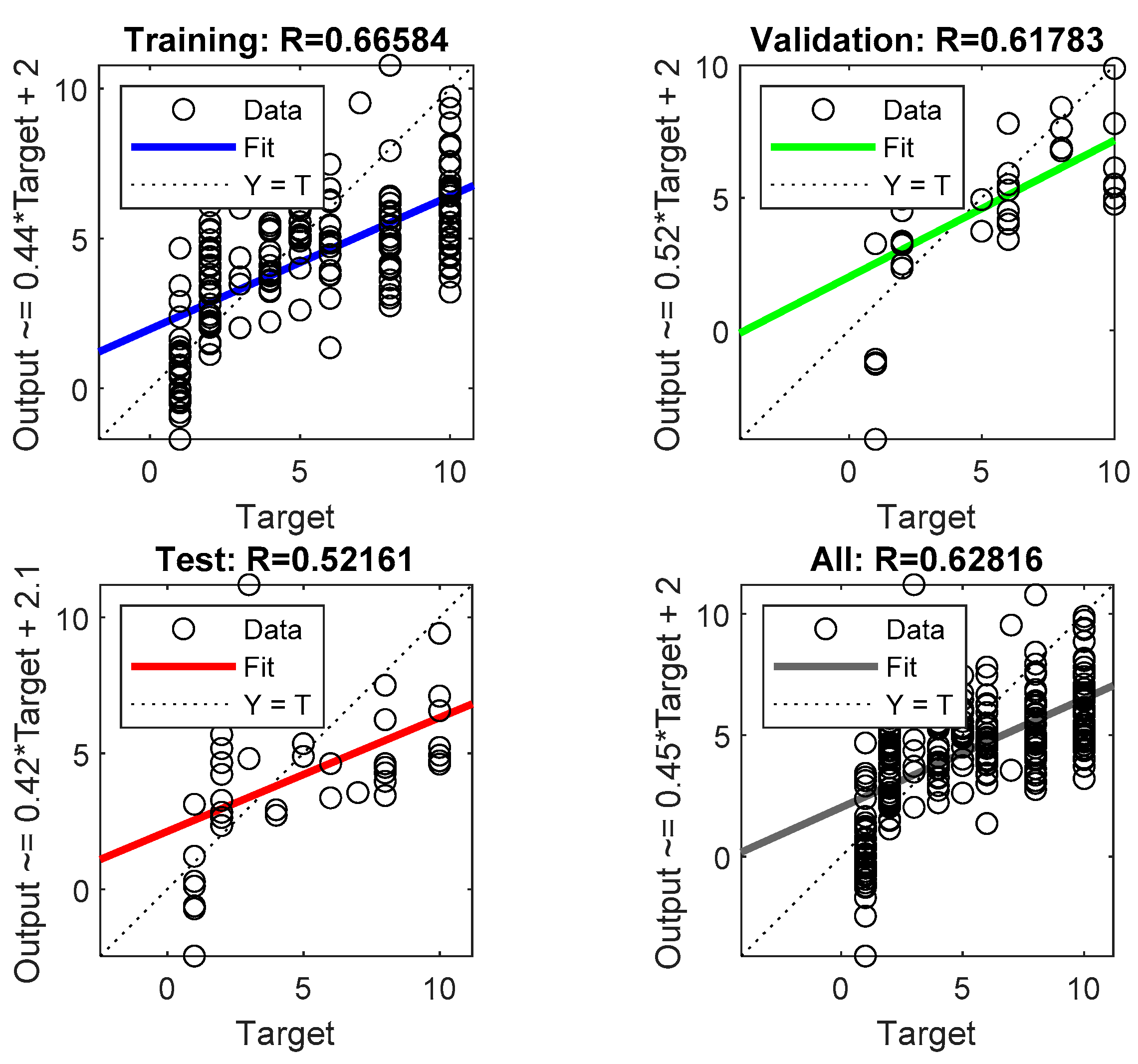

| Ship type | 0.029 |
| Year of construction | 0.531 |
| Wind force | 0.000 |
| Sea conditions | 0.000 |
| Swell | 0.000 |
| Visibility | 0.584 |
| Night | 0.003 |
| Length | 0.000 |
| Beam | 0.000 |
| Cause of the accident | 0.000 |
| Number of crew members | 0.732 |
| Comply minimum crew members | 0.000 |
Disclaimer/Publisher’s Note: The statements, opinions and data contained in all publications are solely those of the individual author(s) and contributor(s) and not of MDPI and/or the editor(s). MDPI and/or the editor(s) disclaim responsibility for any injury to people or property resulting from any ideas, methods, instructions or products referred to in the content. |
© 2024 by the authors. Licensee MDPI, Basel, Switzerland. This article is an open access article distributed under the terms and conditions of the Creative Commons Attribution (CC BY) license (https://creativecommons.org/licenses/by/4.0/).
Share and Cite
Maceiras, C.; Cao-Feijóo, G.; Pérez-Canosa, J.M.; Orosa, J.A. Application of Machine Learning in the Identification and Prediction of Maritime Accident Factors. Appl. Sci. 2024, 14, 7239. https://doi.org/10.3390/app14167239
Maceiras C, Cao-Feijóo G, Pérez-Canosa JM, Orosa JA. Application of Machine Learning in the Identification and Prediction of Maritime Accident Factors. Applied Sciences. 2024; 14(16):7239. https://doi.org/10.3390/app14167239
Chicago/Turabian StyleMaceiras, Candela, Genaro Cao-Feijóo, José M. Pérez-Canosa, and José A. Orosa. 2024. "Application of Machine Learning in the Identification and Prediction of Maritime Accident Factors" Applied Sciences 14, no. 16: 7239. https://doi.org/10.3390/app14167239







